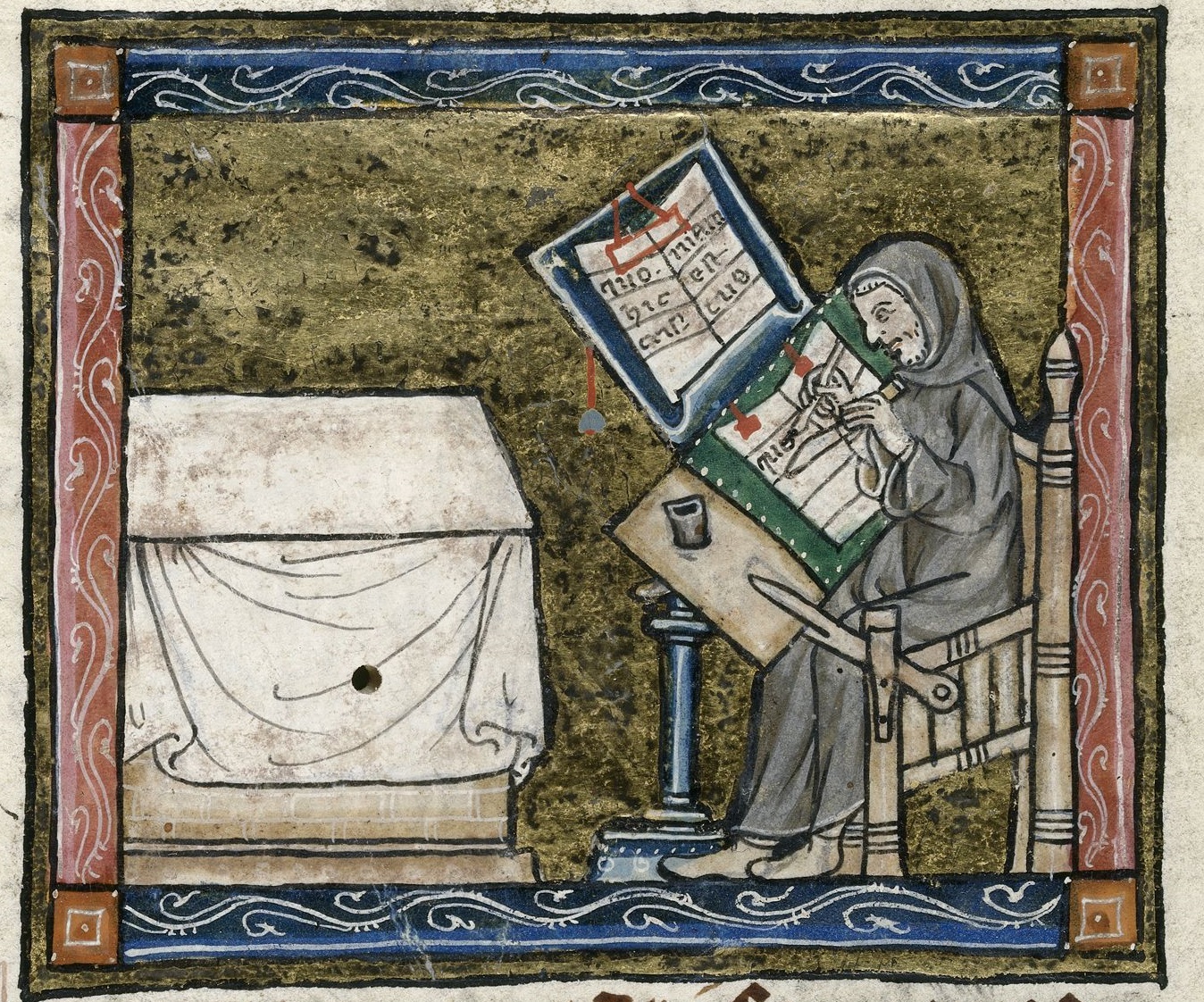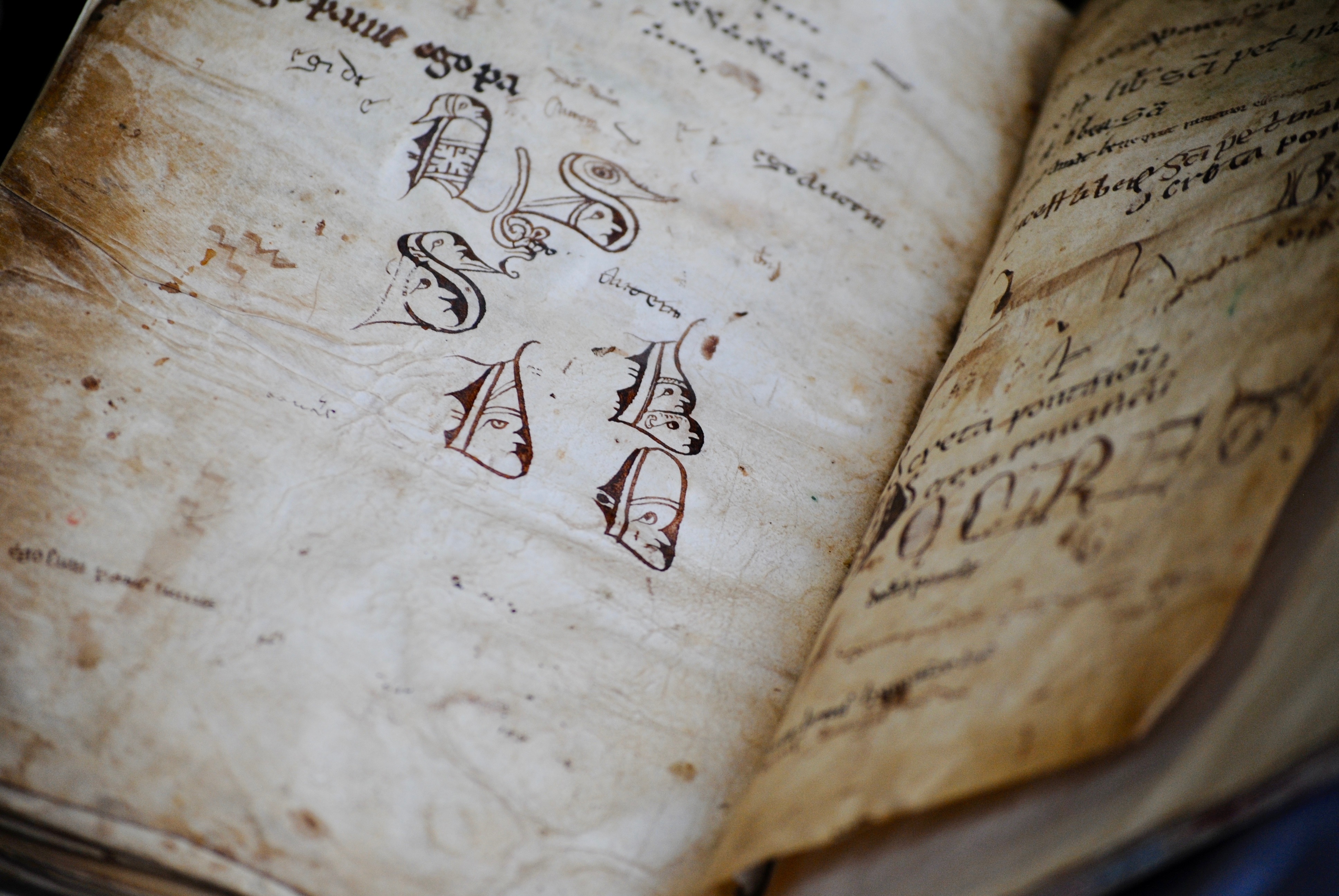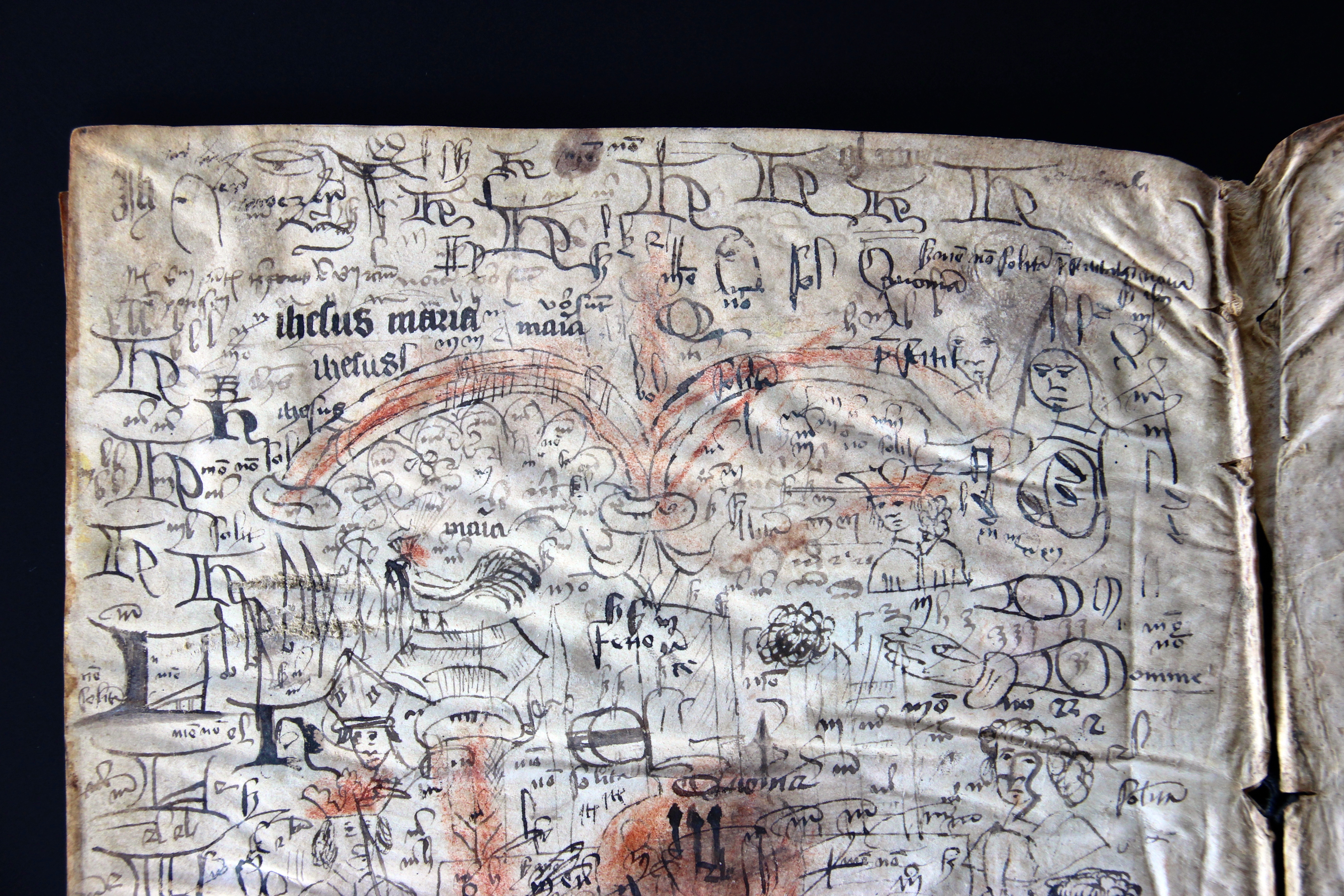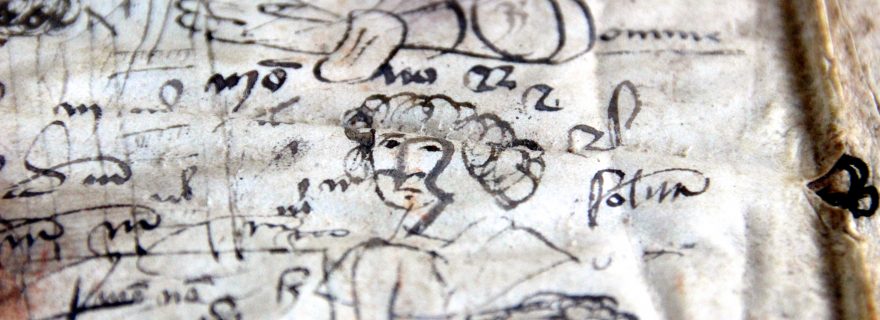Doodling in the Middle Ages
Doodling is something we do all the time: on the phone or attending a meeting we scribble, rather haphazardly and without thinking, squiggly lines, random words or mini drawings. The practice is old and originates in the pen trials of medieval scribes.
Why Pen Trials?
Let’s start at the beginning: why do pen trials exist? The answer lies in the two tools wielded by medieval scribes more than any other instrument. In miniatures scribes are often shown with a pen in one hand and a knife in the other, such as the hermit seen copying text from an exemplar in Figure 1. (Note, incidentally, the handy paraphernalia he has at his disposal, like the slider that helped him keep track of the line he was supposed to copy.) Here we see the scribe using the tip of the knife to keep the parchment in place: using his hands would release oily grease onto the writing surface, which would subsequently prevent the ink from sticking properly.

An equally important use of the knife, however, was to adjust the nib; and it is here that the origins of the pen trial – and the doodle – are found. After a few hours of writing, the nib became dull and it needed to be cut again in order to produce crisp letters. The scribe then tested the nib to check that it had the right width and to make sure there would be no streaks of white in the letters. For this he turned to an empty page to scribble down squiggly lines or short words, as we would today. The process was quick and routine among scribes across medieval Europe.
Palette
Pen trials, which are usually encountered on the flyleaves in the back of manuscripts, can be quite entertaining. As it happened, scribes did not just write down squiggly lines or words when testing their pens, but they even produced modest works of art. In Leiden University Library some great “artistic” specimens are encountered. In the back of BPL 111-I, for example, we find a series of large initial letters with faces inside them (Figure 2): a letter B with two monks (note the tonsures), a D with a stern-looking lady wearing a pointy hat, a bearded person in a letter S, and a duck containing a long-nosed man. This page and the facing one are filled with dozens of pen trials. The shapes of the letters and the ink color suggests that the doodles on these pages were produced by a limited number of individuals, perhaps two or three, which is in line with what we commonly see on flyleaves that contain pen trials.

The two pages in the back of BPL 111-I are also in line with broader European traditions regarding the kind of tests they contain. We encounter single letters and words, as well as nonsensical phrases (“e”, “egi de e”, “ego panne”, “autem”). Another popular theme in pen-trial land is also found here: musical notation, seen near the top of figure 2. The square notes of the Middle Ages were perfect for testing the nib, because they naturally showed how wide it was, while the short square shape also invited the scribe to execute a series of quick strokes. Common also are the little specks visible in Figure 2: you can vaguely see them in the white zone below the initial letters. These result from tapping the quill on the parchment, probably in an attempt to adjust the nib by “tapping” it into shape.
Scriptorium
Leiden University Library also contains a pair of leaves, however, that are anything but common (BPL 3327 (22), partly shown in Figure 3). In this case the pages are filled to the brim with several hundred pen trials: there are more than I have ever seen in one location – note that Figure 3 shows only the top half of one of the pages. When one looks carefully, running themes can be observed across the pages, sometimes clustered in the same location. There is the large capital letter H that is frequently drawn, especially near the top of the page; and there are recurring human figures as well, such as a grumpy lady, a man with curly hair, and a few bishops. Another theme is the nota sign, the attention sign that is encountered in the margins of manuscripts: quite a few are observed under the two red arches (they look like “nt” with a curly line over top).

There is another reason why these test pages stand out from the many others I have encountered. The pen trials in Figure 3 are from more than just a few individuals: variations in ink color, letter shape, and nib width suggest they may have been placed there by as many as ten scribes. In fact, at several locations newer pen trials were written overtop of existing ones, increasing the total number of scribes. Evidently, the sheet was used for a considerable length of time by a` great number of scribes in the same location, most likely a scriptorium. While the sheer number of trials is quite unusual, similar scriptorium “test leaves” are encountered elsewhere, for example in the back of Bodley 340 in the Bodleian Library, where pen trials are found of as many as ten early-twelfth-century monks in Rochester Priory in Kent, England.
Testing, One, Two, Three
Apart from their charm, pen trials are also illuminating. Their use for book historians goes far beyond just seeing confirmed that the medieval pen needed to be cut frequently. The flyleaves in the back of Bodley 340 (and its sister manuscript, Bodley 342, the second part of the set) form the basis, for example, for arguing that the scriptorium of Rochester Abbey was filled with individuals who were trained across the European Continent, including in Germany, Holland and Italy (Kwakkel, “Hidden in Plain Sight”). This verdict is based on the letter shapes of the pen trials, which reveal where their makers are from, while at the same time showing the ethnic diversity of the monks in Rochester Abbey. Likewise, the bifolium BPL 3327 (22) can be used to gauge what scripts were used by individual scribes. Some of the trials are definitely by the same person, yet different script families are tested. These specific pen trials help, in other words, to study how one scribe executed different scripts, which is hard to do with regular resources such as manuscripts. In sum, pen trials represent highly entertaining products of the quill, while they are at the same time a valuable resource for the study of medieval written culture.
Literature
- Erik Kwakkel, “Hidden in Plain Sight: Continental Scribes in Rochester Cathedral Priory, 1075-1150,” in Writing in Context: Insular Manuscript Culture, 500-1200, ed. Erik Kwakkel, Studies in Medieval and Renaissance Book Culture (Leiden: Leiden University Press, 2013), 231-61.


